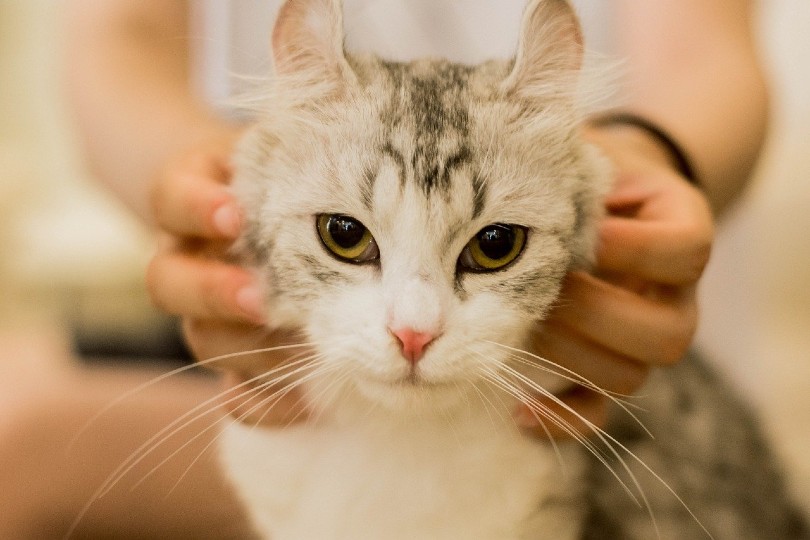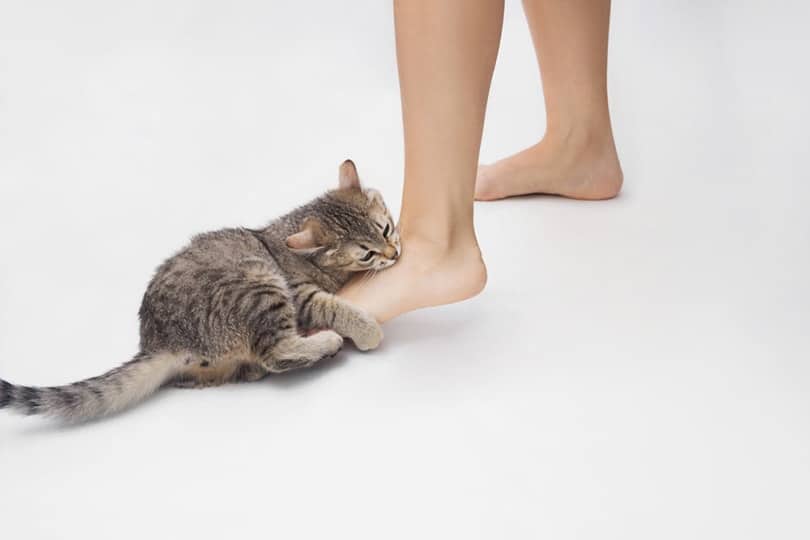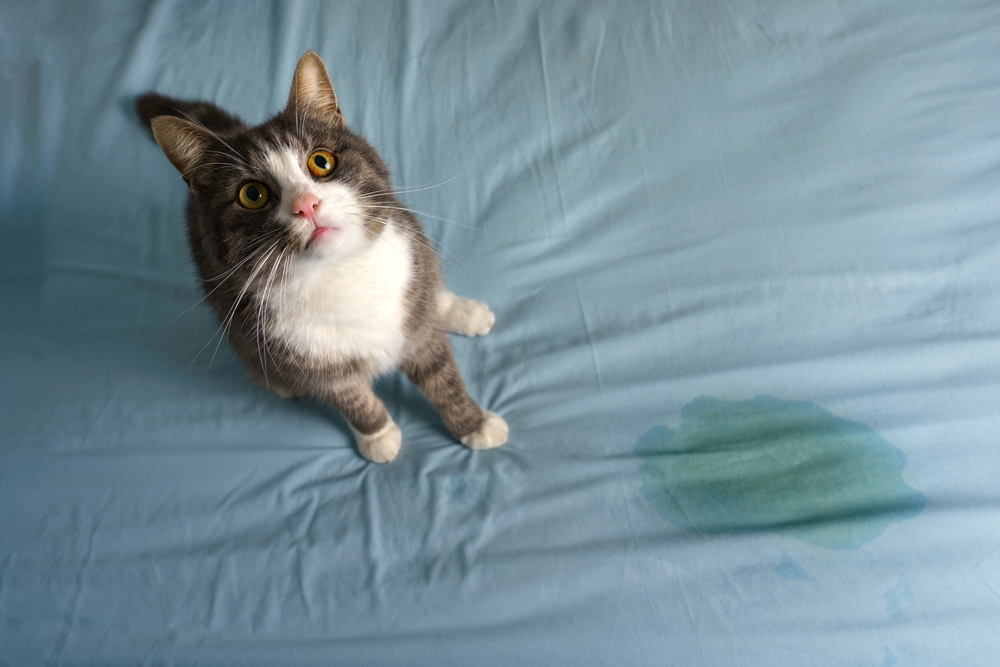Click to Skip Ahead
Your normally happy cat is staring intently outside at something, tail completely straight and ears back. You wonder what is bothering them, so you walk over to your cat and they suddenly lash out at you! Even worse is when you’re both happily enjoying a petting session when, seemingly out of nowhere, she bites your hand. Ouch!
Cat bites and scratches not only hurt but can become serious, as their claws and teeth carry bacteria that could make a cat-induced wound much worse than any normal injury.
Some cats have aggressive tendencies, but some cats with normal day-to-day behavior attack suddenly without much warning. If your own cat has randomly attacked you before, read on to find out why and how to solve the problem.

The 6 Reasons Your Cat Might Attack You
1. Fear

Cats that are exposed to new people, animals, or places can display fear aggression. Fear aggression also comes out when there’s an unpleasant experience underway, like getting ready for a trip to the vet or a loud noise your cat doesn’t like.
| How to Fix it: | Identify the situations that cause fear aggression in your cat and gradually introduce your cat to the stimulus causing the fear, so she can get used to it. If she can see the fear-inducing thing from a distance and watch it come closer without showing unwanted behavior, praise her for this. |
2. Pain
Since cats can’t talk to us, sometimes they attack you when they are experiencing pain for some medical reason, like arthritis. To avoid any touch or movement that might increase their pain, they may hiss, scratch, or bite you.
| How to Fix it: | If you know your cat’s got a sore spot, do not touch that area. Talk with your vet to make a plan to relieve your cat’s pain. |
If you are concerned about the health and well-being of your pet, seek veterinary advice for the best course of action.
If you need to speak with a vet but can't get to one, head over to PangoVet. It's an online service where you can talk to a vet online and get the advice you need for your pet — all at an affordable price!
3. Territorial Reason

Each cat creates and protects its own stomping grounds. If a new cat, other animal, and sometimes new person is introduced to that sacred ground, things can get ugly. Sometimes this even happens to previously ok’d individuals, but maybe they have been gone for a long time. Territorial cats will swat, chase, or attack their intruder.
| How to Fix it: | “Unwelcome” other felines should be introduced or reintroduced very slowly and gradually. Make sure they have their own space, litter box, water, and food bowl. You can also place the two cats in kennels or on harnesses across the room from each other and slowly bring them closer. It’s important not to rush this process if you truly want them to get along. |
4. Dominance
Sometimes a cat wants to run the house and wants everyone to know who’s boss. Cats displaying this behavior will block doorways, bat at other cats who walk by, or bite you when you give another pet attention.
| How to Fix it: | Ignore a cat displaying this behavior. Instead, wait until the cat is in a completely relaxed state, then reward him with praise or treats. |
5. Petting-Induced (Overstimulation)

Cats sometimes love being stroked and scratched, but some cats don’t understand a good way to tell you to stop. This comes out in seemingly random attacks directed at you while you think they are enjoying your attention. Nobody knows exactly why this happens, but the theory behind overstimulation is that cats don’t allow themselves to get too carried away that they make themselves vulnerable, so it’s sort of a defensive move to regain control. Watch for the pupils to become dilated, ears to turn backward, and tail to whip about. Then you know she’s about to show aggression.
| How to Fix it: | Don’t touch or pet the cat in a way she doesn’t like, and learn to identify overstimulation precursors to successfully stop interactions before a bite or swat. |
6. Redirected Aggression
Occasionally a cat will attack you or another pet when it is stimulated by something else. This can happen when your cat sees another stray cat outside or has a bad interaction with another cat.
| How to Fix it: | Remove the thing causing your cat grief by pulling down the window shade or avoiding situations that cause aggression between cats. Do not attempt to interact with your cat during such moments. |

How to Deal with Cat Aggression
We’ve outlined what kinds of behavior aggressive cats display and how to address each one. Now let’s talk about things you can do to further prevent all kinds of cat attacks.
- Be Aware
Half the battle is just knowing the signs your cat displays when he is about to display aggressive behavior. They do this with their face and through bodily signs.
- Facial Aggression Precursor Signs
A cat that is about to attack will have dilated (bigger than usual) pupils, their ears back, and whiskers out to the side. For a fearful aggressive cat, the ears and whiskers will be flat down or against their heads.
- Bodily Aggression Precursor Signs
Signs of fear shown in a cat’s body include standing with an arched back, hairs on haunches standing on end, an erect tail, and ears flattened to the head. Other bodily fear aggression signs in a cat include crouching low, ears to the sides of their head, with the cat’s tail under them. Sometimes they will hiss and bare their teeth, too.
- Don’t Reward the Behavior
When you see these precursors of aggression signs, it’s a bad time to pet and console your cat, even if he is scared. This will only encourage him to continue the behavior. You also don’t want to show fearfulness or retreat from your cat if that’s what he wants you to do. The best thing to do is to ignore their bad behavior and reward him when he’s displaying appropriate behavior.
- Never Get in the Way
If two cats are fighting, never put any body part between or get in the way of a fight, as you could get injured. It’s best to use something like a piece of cardboard or a baby gate to separate two fighting cats.
- Visit the Vet
Always talk to your vet when your cat has an aggression issue. A vet can rule out any causes of pain-induced aggression and prescribe any needed medication. The vet might also recommend you to a behaviorist if necessary.
Additional Information

Conclusion
Cats, like all animals, usually have a reason for doing what they do, whether we know that reason or not. Don’t assume a cat is being bad if they are attacking you. It could be difficult not to cry out or retaliate if they abuse you. Try to see the reason behind the behavior, and then you can more quickly ease your and your cat’s woes.
Related reads:
Featured Image Credit: Anna Kraynova, Shutterstock











What do you do if your cat attacks your harmless dog viciously?
Hi Eden, you might find some information of the possible reasons along with great tips and tricks to improve your cat and dog’s relationship in the following posts:
Why Does My Cat Swat the Dog? 6 Reasons & How to Stop Them-
https://www.catster.com/cat-behavior/why-does-my-cat-swat-the-dog/
10 Ways to Help Cats and Dogs Get Along Better- https://www.catster.com/lifestyle/how-to-make-dogs-and-cats-get-along/
And
How to Get a Cat and Dog to Get Along-
https://www.catster.com/lifestyle/how-to-bond-cat-and-dog/
If you need further assistance, please do not hesitate to book a consultation at www.pangovet.com, they can help you go through the particulars of your pet’s case and suggest some great solutions.
Best wishes